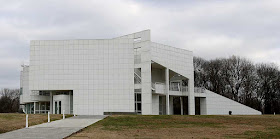For a long while I have wanted to visit New Harmony, Indiana USA. On my list of things to see is a weather vane on top of a building built for Indiana's first state geologist David Dale Owen. As the it was the last of his buildings completed in his lifetime (1860 year of his death). The top room with a conical roof is a unique weather vane(?) that consists of replicas of three fossils: a fish, bryozoan, and blastoid.
Owen had a great idea with this weather vane. The fossil selection reflects his, Charles-Alexandre Lesueur and Thomas Say's contributions to paleontology. When I came across images of this in books or on-line I was always intrigued by its symbolism.
The bottom fossil is the re-creation of a stem section and
Pentremite blastoid fossil. The
Pentremite was name by Thomas Say in November 1820 (
Observations on some Species of Zoophytes, Shells, &c., principally Fossil The American Journal of Science and Arts, VOL. II, No. 2, pages 34–45). See scan of this entire journal on
Google Books.
The middle section is an
Archimedes bryozoan fossil. It was named by David Dale Owen in the report entitled
A Geological Reconnoisance and Survey of the State of Indiana in 1837 and 1838. He wrote,
"In the bed of Oil creek, then, on the road from Troy to Fredonia, the coal sandstone may be found resting on a reddish stratum of a somewhat arenaceous limestone, the uppermost member of this sub-carboniferous group, and characterized by a fossil, described by Lesueur under the name of Archimides, on account of its screw-like form. "
It is interesting that Charles-Alexandre Lesueur named this fossil as it reminded him of a screw
Archimedes of Syracuse (287-212 BC) is credited with creating. Lesueur was a resident of New Harmony from 1826-1837, before moving back to France. Learn more about this at University of Evansville's Clark Kimberling
web page on this subject.
The fish at the top is what caused me quite a bit of research and puzzlement as to what it is. I speculate that it might be Owen's interpretation of
Macropetalichthys rapheidolabis. He and Joseph Granville Norwood, M.D, L.L.D. (Woodford County, Kentucky 12/20/1807-5/6/1895 Columbia, Missouri) described a fossil found in northwest Indiana in the American Journal of Science in an 1846 article,
Description of a New Fossil Fish from the Paleozoic Rocks of Indiana pages 367-371.
The article describes the fossil specimen being found "fifteen miles N.W. of Madison, Jefferson county, Indiana, in the rock forming the bed of Lewis's creek, a branch of the Muskatatac River."
They also note the quarryman who found the fossil had damaged it as it was being extracted. Below are figures from their article of this fossil.
I have not found a rendering of what this complete fish looks like. The roof of the skull of the fish is at the Smithsonian catalog number USNM PAL 265273. They also have another 24 specimens of this genus listed in their database. The
database for the American Museum of Natural History shows 37 specimens in that collection.
The problem is that is a Devonian Period armored fish in either the Order of Petalichthyids or Arthrodires. Neither those types of fish look at all like what is on the weather vane. Of course in the mid-1800s I am not sure there were enough specimens collected to know that the creature looked like. His 1846 article also mentions the fossil is similar to the
Pterichthys cornutus and
Chondropterygii. Neither of these fish look like what is depicted on the weather vane either.
So what if the fish model is the Devonian Period
Cheirolepis trailli named in 1835 by Agassiz. This fossil was found in Scotland where Owen was born in 1807 and migrated from in 1827 [side note]. Owen and Agassiz both associated with paleobotanist
Leo Lesquereux who worked with Agassiz in the 1840s on European peat bogs and Owen in the 1850s-1860s on fossil plants found in coal deposits. So they could have known of each other's work through him. Louis Agassiz (1807-1873) was also familiar with Lesueur from New Harmony as they were both fish experts. So it could be assumed that Owen was familiar with his work through that connection or that Agassiz knew of the geological work going on at New Harmony. In addition, Agassiz moved to the United States in 1846 so they were at least in the same country and possibly in the same academic circles.
Below are images of the
Cheirolepis trailli fossil and its label at the American Museum of Natural History in New York City. It has similarities to the one on the weather vane. It and the
Macropetalichthy both Devonian and the
Cheirolepis is found more intact. Maybe it was used as a model for this fossil fish or I am just barking up the wrong weather vane with my guess. If anyone reading these knows the name of that fish please let me know...



















































